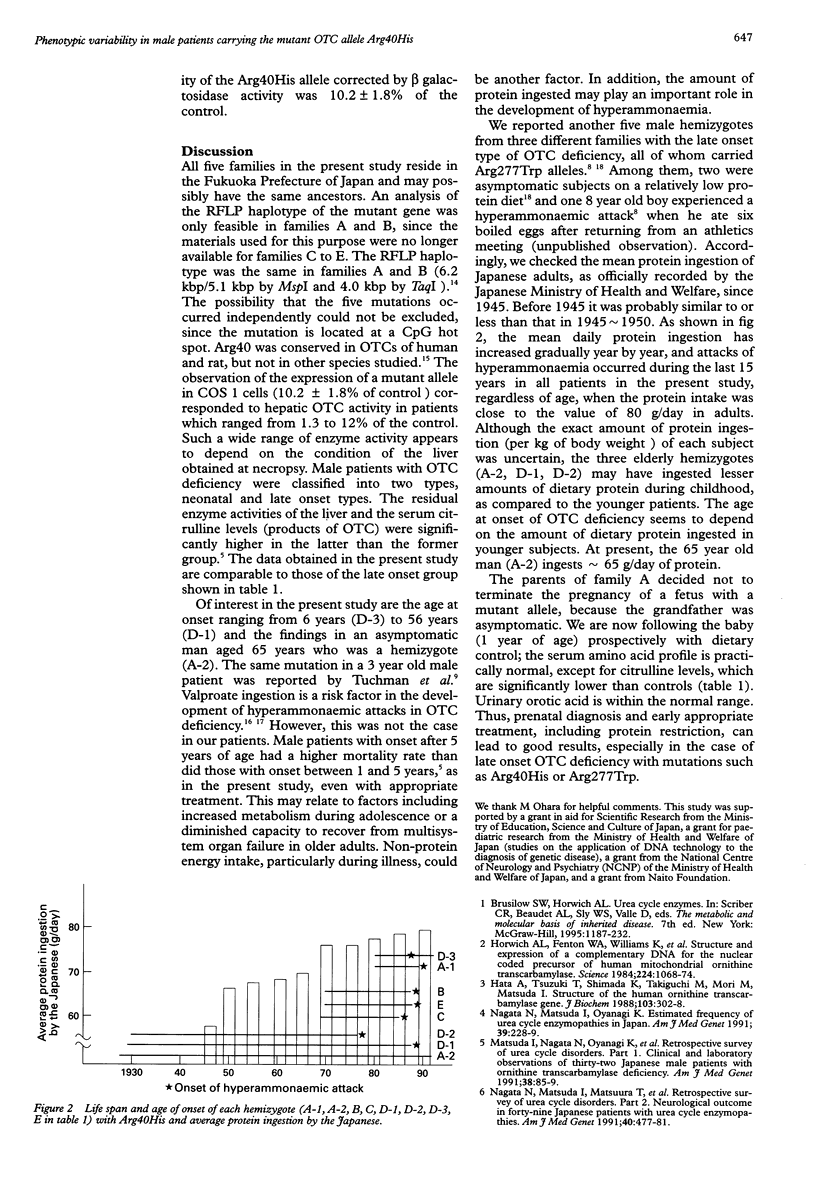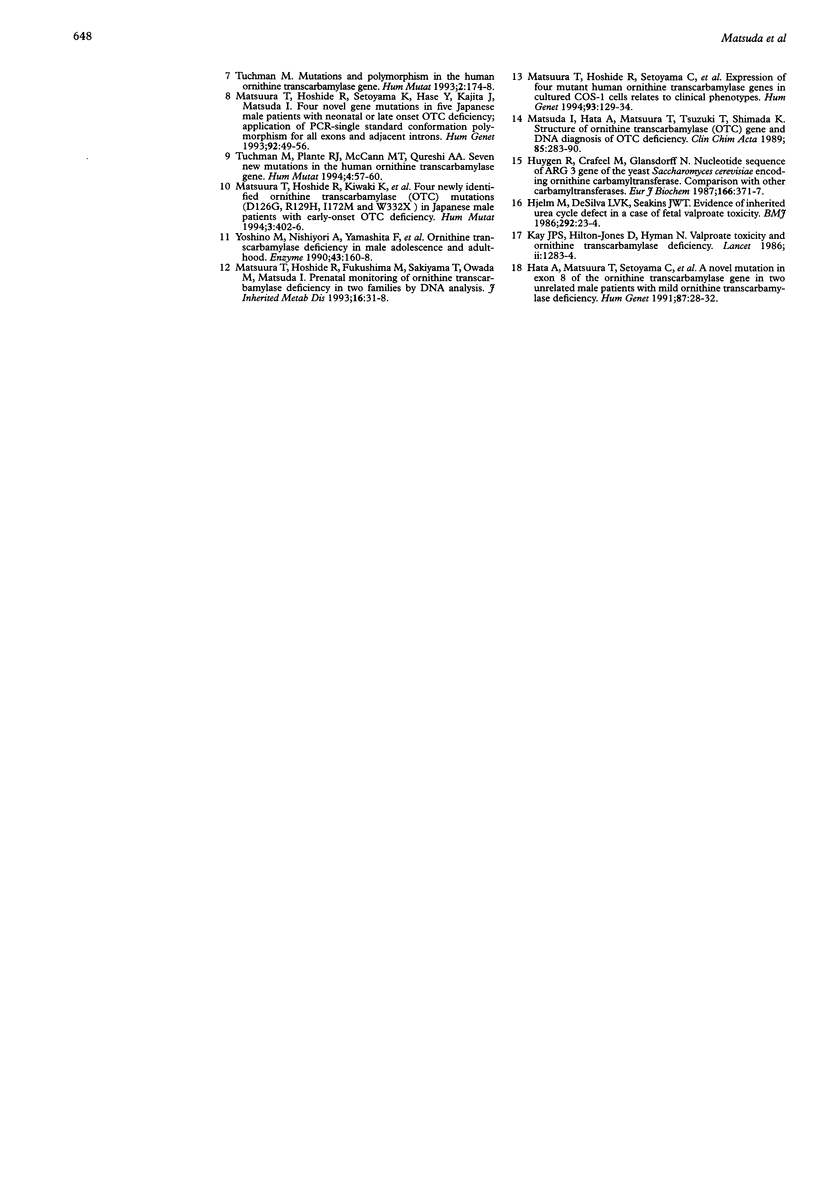Abstract
In five different Japanese families, we identified six male hemizygotes (aged 6, 9, 15, 17, 56, and 65 years) and a putative candidate (aged 48 years), carrying a mutant allele of the ornithine transcarbamylase (OTC) gene, a G to A substitution at nucleotide 119 in exon 2 generating histidine in place of arginine. OTC activity in the necropsied liver tissue was reduced to approximately 12% of the control and that of COS 1 cells transfected with Arg40His OTC cDNA was 10.2 +/- 1.8% of the control transfected with wild type OTC cDNA. Clinical features ranged from death during a hyperammonaemic attack (a 9 year old) to a 65 year old asymptomatic man. We consider that the amount of protein ingested by these subjects may be one predisposing factor leading to the manifestation of this disease.
Full text
PDF



Images in this article
Selected References
These references are in PubMed. This may not be the complete list of references from this article.
- Hata A., Matsuura T., Setoyama C., Shimada K., Yokoi T., Akaboshi I., Matsuda I. A novel missense mutation in exon 8 of the ornithine transcarbamylase gene in two unrelated male patients with mild ornithine transcarbamylase deficiency. Hum Genet. 1991 May;87(1):28–32. doi: 10.1007/BF01213087. [DOI] [PubMed] [Google Scholar]
- Hata A., Tsuzuki T., Shimada K., Takiguchi M., Mori M., Matsuda I. Structure of the human ornithine transcarbamylase gene. J Biochem. 1988 Feb;103(2):302–308. doi: 10.1093/oxfordjournals.jbchem.a122265. [DOI] [PubMed] [Google Scholar]
- Hjelm M., de Silva L. V., Seakins J. W., Oberholzer V. G., Rolles C. J. Evidence of inherited urea cycle defect in a case of fatal valproate toxicity. Br Med J (Clin Res Ed) 1986 Jan 4;292(6512):23–24. doi: 10.1136/bmj.292.6512.23. [DOI] [PMC free article] [PubMed] [Google Scholar]
- Horwich A. L., Fenton W. A., Williams K. R., Kalousek F., Kraus J. P., Doolittle R. F., Konigsberg W., Rosenberg L. E. Structure and expression of a complementary DNA for the nuclear coded precursor of human mitochondrial ornithine transcarbamylase. Science. 1984 Jun 8;224(4653):1068–1074. doi: 10.1126/science.6372096. [DOI] [PubMed] [Google Scholar]
- Huygen R., Crabeel M., Glansdorff N. Nucleotide sequence of the ARG3 gene of the yeast Saccharomyces cerevisiae encoding ornithine carbamoyltransferase. Comparison with other carbamoyltransferases. Eur J Biochem. 1987 Jul 15;166(2):371–377. doi: 10.1111/j.1432-1033.1987.tb13525.x. [DOI] [PubMed] [Google Scholar]
- Kay J. D., Hilton-Jones D., Hyman N. Valproate toxicity and ornithine carbamoyltransferase deficiency. Lancet. 1986 Nov 29;2(8518):1283–1284. doi: 10.1016/s0140-6736(86)92714-5. [DOI] [PubMed] [Google Scholar]
- Matsuda I., Hata A., Matsuura T., Tsuzuki T., Shimada K. Structure of the ornithine transcarbamylase (OTC) gene and DNA diagnosis of OTC deficiency. Clin Chim Acta. 1989 Dec 15;185(3):283–289. doi: 10.1016/0009-8981(89)90218-0. [DOI] [PubMed] [Google Scholar]
- Matsuura T., Hoshide R., Fukushima M., Sakiyama T., Owada M., Matsuda I. Prenatal monitoring of ornithine transcarbamoylase deficiency in two families by DNA analysis. J Inherit Metab Dis. 1993;16(1):31–38. doi: 10.1007/BF00711312. [DOI] [PubMed] [Google Scholar]
- Matsuura T., Hoshide R., Kiwaki K., Komaki S., Koike E., Endo F., Oyanagi K., Suzuki Y., Kato I., Ishikawa K. Four newly identified ornithine transcarbamylase (OTC) mutations (D126G, R129H, I172M and W332X) in Japanese male patients with early-onset OTC deficiency. Hum Mutat. 1994;3(4):402–406. doi: 10.1002/humu.1380030415. [DOI] [PubMed] [Google Scholar]
- Matsuura T., Hoshide R., Setoyama C., Komaki S., Kiwaki K., Endo F., Nishikawa S., Matsuda I. Expression of four mutant human ornithine transcarbamylase genes in cultured Cos 1 cells relates to clinical phenotypes. Hum Genet. 1994 Feb;93(2):129–134. doi: 10.1007/BF00210596. [DOI] [PubMed] [Google Scholar]
- Matsuura T., Hoshide R., Setoyama C., Shimada K., Hase Y., Yanagawa T., Kajita M., Matsuda I. Four novel gene mutations in five Japanese male patients with neonatal or late onset OTC deficiency: application of PCR-single-strand conformation polymorphisms for all exons and adjacent introns [corrected]. Hum Genet. 1993 Aug;92(1):49–56. doi: 10.1007/BF00216144. [DOI] [PubMed] [Google Scholar]
- Nagata N., Matsuda I., Matsuura T., Oyanagi K., Tada K., Narisawa K., Kitagawa T., Sakiyama T., Yamashita F., Yoshino M. Retrospective survey of urea cycle disorders: Part 2. Neurological outcome in forty-nine Japanese patients with urea cycle enzymopathies. Am J Med Genet. 1991 Sep 15;40(4):477–481. doi: 10.1002/ajmg.1320400421. [DOI] [PubMed] [Google Scholar]
- Nagata N., Matsuda I., Oyanagi K. Estimated frequency of urea cycle enzymopathies in Japan. Am J Med Genet. 1991 May 1;39(2):228–229. doi: 10.1002/ajmg.1320390226. [DOI] [PubMed] [Google Scholar]
- Tuchman M. Mutations and polymorphisms in the human ornithine transcarbamylase gene. Hum Mutat. 1993;2(3):174–178. doi: 10.1002/humu.1380020304. [DOI] [PubMed] [Google Scholar]
- Tuchman M., Plante R. J., McCann M. T., Qureshi A. A. Seven new mutations in the human ornithine transcarbamylase gene. Hum Mutat. 1994;4(1):57–60. doi: 10.1002/humu.1380040109. [DOI] [PubMed] [Google Scholar]
- Yoshino M., Nishiyori J., Yamashita F., Kumashiro R., Abe H., Tanikawa K., Ohno T., Nakao K., Kaku N., Fukushima H. Ornithine transcarbamylase deficiency in male adolescence and adulthood. Enzyme. 1990;43(3):160–168. doi: 10.1159/000468724. [DOI] [PubMed] [Google Scholar]



